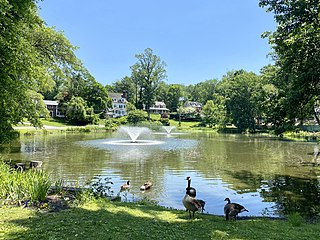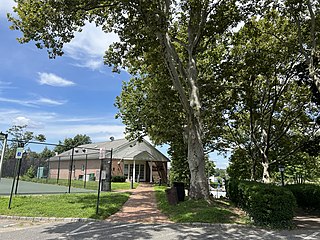
East Hills is a village in Nassau County, on the North Shore of Long Island, in New York, United States. It is considered part of the Greater Roslyn area, which is anchored by the Incorporated Village of Roslyn. The population was 7,284 at the time of the 2020 census.

Flower Hill is a village in Nassau County, on the North Shore of Long Island, in New York, United States. The eastern half is considered part of the Greater Roslyn area, which is anchored by the Incorporated Village of Roslyn. Western and northern parts are more closely associated with Manhasset and Port Washington. The population was 4,794 at the time of the 2020 census.

Manhasset is a hamlet and census-designated place (CDP) in Nassau County, on the North Shore of Long Island, in New York, United States. It is considered the anchor community of the Greater Manhasset area. The population was 8,176 at the 2020 census.

Roslyn is a village in the Town of North Hempstead in Nassau County, on the North Shore of Long Island, in New York, United States. It is the Greater Roslyn area's anchor community. The population was 2,988 at the 2020 census.

Roslyn Estates is a village in the Town of North Hempstead in Nassau County, on the North Shore of Long Island, in New York, United States. It is considered part of the Greater Roslyn area, which is anchored by the Incorporated Village of Roslyn. The population was 1,318 at the 2020 census.

Roslyn Harbor is a village in Nassau County, on the North Shore of Long Island, in New York, United States. It is considered part of the Greater Roslyn area, which is anchored by the Incorporated Village of Roslyn. The population was 1,051 at the 2010 census.

Roslyn Heights is a hamlet and census-designated place (CDP) in the Town of North Hempstead in Nassau County, on the North Shore of Long Island, in New York, United States. It is considered part of the Greater Roslyn area, which is anchored by the Incorporated Village of Roslyn. The population was 6,747 at the time of the 2020 census.

Saddle Rock is a village on the Great Neck Peninsula in the Town of North Hempstead, in Nassau County, on the North Shore of Long Island, in New York, United States. The population was 989 at the time of the 2020 census.

The Mill Dam Bridge carries Mill Dam Road across the tidal mudflat of Centerport Harbor on the North Shore of Long Island, in Centerport, Suffolk County, New York. It divides the navigable waters of the harbor from the Mill Pond formed by its tidegates.

Roslyn is a station on the Long Island Rail Road's Oyster Bay Branch. It is located at Lincoln Avenue and Railroad Avenue, west of Roslyn Road and south of Warner Avenue, in Roslyn Heights, in Nassau County, New York.

Monfort Cemetery is a historic cemetery located 250 feet (76 m) east of the intersection of Port Washington Boulevard and Main Street in Port Washington, New York, United States.

The Main Street Historic District is one of two such districts in the village of Roslyn, New York. It is, as its name suggests, located along Main Street between North Hempstead Turnpike and East Broadway, incorporating Tower Street and portions of Glen Avenue and Paper Mill Road.

The Clayton-Cedarmere Estates are located in Roslyn Harbor, New York, United States, listed jointly on the National Register of Historic Places in 1986. Clayton, the bulk of the property, is the large landscaped Bryce/Frick estate, now home to the Nassau County Museum of Art. Cedarmere, the smaller of the two, is William Cullen Bryant's estate, currently undergoing interior renovation, is located on the west side of Bryant Avenue; overlooking Hempstead Harbor, now a historic house museum. The grounds are open to the public. The two combined properties, with input from several notable architects, illustrate the development of estates on the North Shore of Long Island over a period of nearly a century.

Haviland-Davison Grist Mill is a historic grist mill located at East Rockaway in Nassau County, New York. It was restored and relocated to its present site in Memorial Park in 1963. It was built about 1689 and is a 2+1⁄2-story, T-shaped, timber-frame building. The original section has one large addition and two smaller wings attached to each side.

The George Washington Denton House is a historic home located in the Incorporated Village of Flower Hill, in Nassau County, on Long Island, in New York, United States. It was built sometime between 1873 and 1875. It was listed on the National Register of Historic Places in 1985 and was designated a Village of Flower Hill Historic Landmark in 1996.

Saddle Rock Grist Mill is a historic grist mill building located in Saddle Rock, a village in the town of North Hempstead in Nassau County, New York. It is a 2+1⁄2-story gambrel-roofed structure. Adjacent is a stream-fed millpond that is supplemented by tidal water impounded by the dam. It dates to the 18th century and is the only extant, operating tidal grist mill on Long Island. The building underwent restoration in the 1950s and is operated as a local history museum.

Strathmore is an unincorporated, Levitt & Sons-developed hamlet in the Town of North Hempstead in Nassau County, on the North Shore of Long Island, in New York, United States, within the census-designated place (CDP) of Manhasset.

The Roslyn Landmark Society is a nonprofit historical society headquartered at 36 Main Street in Roslyn, New York. It serves as the historical and landmark society for the Greater Roslyn area.
Old Northern Boulevard is a major, 2.4-mile (3.9 km) road in Nassau County, on Long Island, New York. It is a bypassed section of Northern Boulevard between Middle Neck Road in Flower Hill & The Locusts in Roslyn Estates, east through Roslyn, with NY 25A being the termini for both ends of the road.























